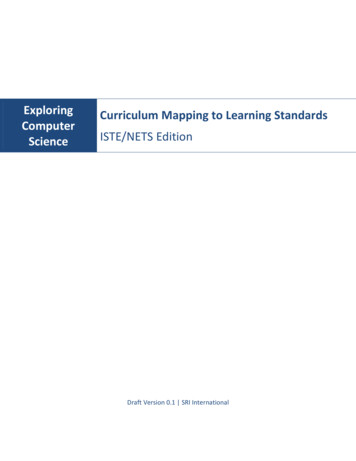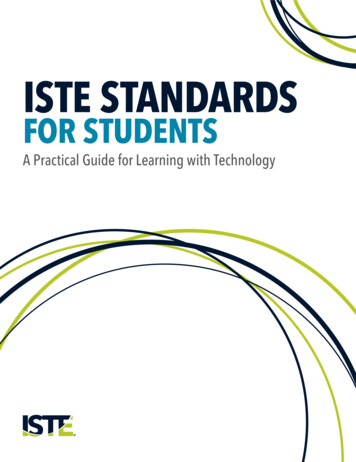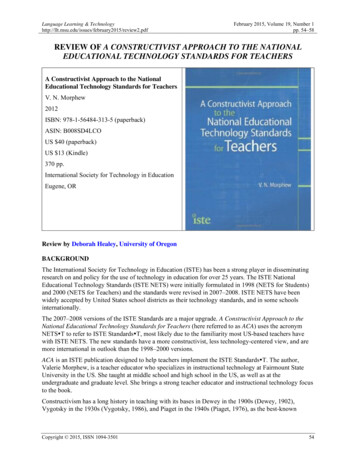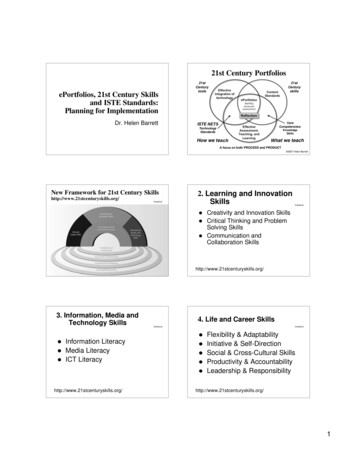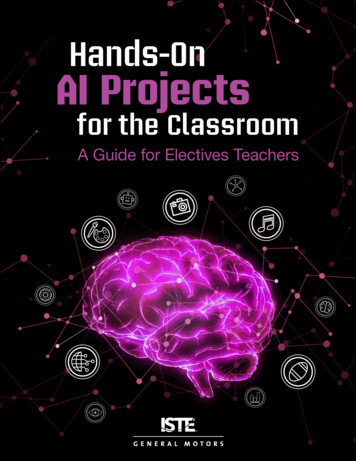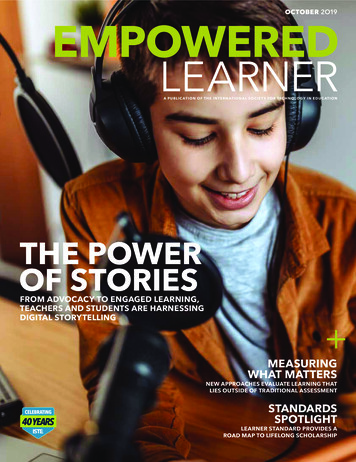
Transcription
october 2O19A PU B L I C AT I O N O F T H E I N T E R N AT I O N A L S O C I E T Y FO R T E C H N O LO G Y I N E D U C AT I O NTHE POWEROF STORIESFROM ADVOCACY TO ENGAGED LEARNING,TEACHERS AND STUDENTS ARE HARNESSINGDIGITAL STORYTELLING MEASURINGWHAT MATTERSNEW APPROACHES EVALUATE LEARNING THATLIES OUTSIDE OF TRADITIONAL ASSESSMENTSTANDARDSSPOTLIGHTLEARNER STANDARD PROVIDES AROAD MAP TO LIFELONG SCHOLARSHIP1EMPOWERED LEARNER
2EMPOWERED LEARNER
Inspire your practice with ISTE podcasts!ISTE podcasts tackle critical edtech topics and introduce youto key education influencers. Listen today and be inspired totransform your practice tomorrow!Your EdtechQUESTIONSEDINFLUENCERSGet answers to important questionsat the juncture of edtech researchand classroom practice. Releasedevery other week, guests answerreal questions from real educators.Hear about the motivations,aspirations and passion projects oftoday’s most prominent educationinnovators. In each episode, ISTE ChiefLearning Officer Joseph South findsout what makes these influencers tick.Tweet your questions to @iste with#youredtechquestions!Stay up to date on guests and topics at#EdInfluencers.Listen wherever you get your podcasts!iste.org/podcastsEMPOWERED LEARNER1
October 2019Volume three Issue twoA quarterly magazine4 about us6 iste in actionRichard CulattaShaping the future is in our DNA8 member voicesDarryl JoynerLeaders must be the changethey want to see10 interviewManoush ZomorodiMedia entrepreneur shares herviews on where technology istaking us, how we can make ita positive experience15 global focusA world without borders isa boon for educator learning16 featureMeasuring what mattersNew approaches evaluatelearning that lies outside oftraditional assessment24 what worksSketchnoting engages studentswhile building comprehension2EMPOWERED LEARNER26 coverThe power of storiesFrom advocacy to engagedlearning, teachers andstudents are harnessingdigital storytelling
CONTENTS33 standards spotlightLearner standard provides a roadmap to lifelong scholarship38 member profileSean ArnoldDrawing from an eclectic work history,he meets the needs of diverse learners41 take actionKaren Richardson, Ph.D.Make equity, diversity part ofadvocacy efforts44 community voicesWhat are the best tools and resourcesto support English language learners?EMPOWERED LEARNER3
executive editorJulie Phillips Randlesdirector ofeditorial contentDiana FingalcontributorsHelen CromptonJerry FingalChris FrisellaNicole Kruegerart directorSharon Adlisiste ceoRichard Culattachief learning officerJoseph Southiste presidentBill BassInnovation Coordinator for InstructionalTechnology, Information and Library MediaParkway School Districtiste immediate past presidentMila Thomas Fuller, Ed.D.Assistant Director of Online LearningUniversity of Illinois at Urbana-ChampaignCollege of Educationempowered learneradvisory panelBijal Damani, Rajkot, Gujarat, IndiaMatt Hiefield, Beaverton, OregonNicol Howard, Redlands, CaliforniaCarol Kelley, Ed.D., Oak Park, IllinoisJanice Mak, Phoenix, ArizonaLuis Perez, Ph.D., St. Petersburg, FloridaJason Trinh, Toronto, Ontario, CanadaJorge Valenzuela, Richmond, VirginiaThe International Society for Technology in Education (ISTE)is a nonprofit organization that works with the globaleducation community to accelerate the use of technologyto solve tough problems and inspire innovation. Ourworldwide network believes in the potential technologyholds to transform teaching and learning.ISTE sets a bold vision for education transformation throughthe ISTE Standards, a framework for students, educators,administrators, coaches and computer science educatorsto rethink education and create innovative learningenvironments. ISTE hosts the annual ISTE Conference &Expo, one of the world’s most influential edtech events.The organization’s professional learning offerings includeonline courses, professional networks, year-roundacademies, peer-reviewed journals and other publications.ISTE is also the leading publisher of books focused ontechnology in education. For more information or tobecome an ISTE member, visit iste.org. Subscribe to ISTE’sYouTube channel and connect with ISTE on Twitter,Facebook and LinkedIn.Our vision. ISTE’s vision is that all educators are empoweredto harness technology to accelerate innovation in teachingand learning, and inspire learners to reach their greatestpotential.Our mission. ISTE inspires educators worldwide to usetechnology to innovate teaching and learning, accelerategood practice and solve tough problems in education byproviding community, knowledge and the ISTE Standards,a framework for rethinking education and empoweringlearners.Subscriptions. ISTE members receive Empowered Learner each quarteras a membership benefit. Members can purchase additional subscriptionsfor 49 per year. Nonmembers can subscribe to Empowered Learner for 100 a year. To subscribe, please visit iste.org/EmpoweredLearner orcontact our customer service department by emailing iste@iste.org orcalling 800.336.5191.About Empowered Learner. Empowered Learner ISSN 2573-1807 (print),Empowered Learner ISSN 2573-2137 (online) is published quarterly by theInternational Society for Technology in Education, 621 SW Morrison Street,Suite 800, Portland, OR 97205, USA. Periodicals postage paid at Portland,Oregon, and at additional mailing office. Send address changes to the ISTEmembership department at 621 SW Morrison Street, Suite 800, Portland,OR 97205, USA.Copyright 2019 ISTE. All rights reserved. The contents of this publicationmay not be reproduced by any means, in whole or in part, without theprior written consent of the publisher. Published October 2019.For information on advertising in future issues ofEmpowered Learner, please email advertise @iste.org.Stay connected iste.org4EMPOWERED LEARNER
Thank you,ISTE Corporate MembersIt takes a community to effect change.ISTE Corporate Members are valuable alliesin our work to transform education!Adobe Systems Inc.Discovery EducationOdysseywareAT&T AspireEdmentumOverDrive EducationBackpack InteractiveGoogle Inc.BrainPOP LLCHappy CodeRuckus Networks (an ARRIScompany)Cambium Learning Group, Inc.IBEC LATAMCanon U.S.A. Inc.ibossCDW-GKneoWorld IncCiscoLearn PlatformcodeSparkLEGO EducationD2L CorporationMDRDell EMCMERGEDigital Media AcademyMicrosoft CorporationSchoologySMART TechnologiesTechnology BoxTECHNOKids Philippines Inc.TexthelpUnity TechnologiesVIPKidZoobean, Inc.Corporate members as of July 15, 2019.Join our corporate member community! iste.org/CorpMembershipEMPOWERED LEARNER5
ISTE IN ACTIONphoto by s te v e smithRichard Culatta reflects on ISTE’s history,looks ahead to the next decade.Shaping the futureis in our DNABy Richard CulattaISTE CEOI recently came across the T-shirt I was givenwhen I volunteered at the 30th ISTE conference. In case you’re wondering, it still fits,as does the role ISTE has played in helpingme stay ahead of important innovations ineducation.ISTE has always been about seeing thefuture and helping shape that future in a waythat’s most helpful for students and teachers.That’s been true for 40 years now, and aswe look forward to the next decade, that rolewill remain unchanged. We’re focused on thesame critical education issues: equity, supporting teachers, preparing students for thefuture and improving the quality of digitallearning tools.And while our focus remains the same,how we go about achieving these goals mustcontinue to evolve in our rapidly changingworld. As we celebrate ISTE’s 40th anniversary, let’s take a minute to look at howour work will unfold over the next decade.Championing equityISTE’s always been a champion for equity ineducation. Ten years ago that largely meant6EMPOWERED LEARNERensuring students and teachers had accessto technology. It was about providing thatbasic connection.Moving forward, it will be about makingsure we’re using the tech we have in ways thatclose achievement gaps, ensure accessibility and teach all students how to be activelearners. It’s also about ensuring our ownISTE community reflects the diverse rangeof educator voices and viewpoints.Supporting teachersSupporting teachers is another area whereour role has been consistent. Over the lastdecade, that meant creating in-person andvirtual networks of early innovators whowere among the first to use technology intheir schools.Today and into the future it meansmaking sure every teacher is prepared tothrive in tech-enabled classrooms. That’swhy we made ISTE Certification for Educators available to all teachers, not just ISTEmembers. It’s also why ISTE is workingclosely with higher ed institutions to ensurethat new teachers arrive fully prepared to usetechnology effectively in their classroomsfrom day one.Preparing studentsWhen it comes to students, ISTE has alwaysbeen future focused. Ten years ago thatmeant making sure students knew how tofind and use the great online resources thatwere available to them.Over the next 10 years it will be abouthelping them use tech not to passively receive information but to create, design andsolve problems. They’ll need to know howto harness AI and computational thinkingskills to be workforce-ready. And they’llneed to understand how to be effective digital citizens, using tech in a balanced way thatpositively impacts the world around them.Improving quality of digital toolsISTE has long worked with tech developersand solution providers to help them buildbetter tools for learning. In the last decade,that meant creating opportunities for interaction between educators and productdevelopers to ensure educator feedback was
“Over the next 10 years itwill be about helping themuse tech not to passivelyreceive information but tocreate, design and solveproblems. They’ll need toknow how to harness AIand computational thinkingskills to be workforce-ready.”included in product design. It also includedcreating our Seal of Alignment program torecognize products that are aligned to theISTE Standards.In the next 10 years, this focus will beexpanded to meet the rising bar for techtool quality. We’ll be working more closelywith solution providers to not only alignto the ISTE Standards, but also to embedsolid principles of the learning sciences,interoperability and accessibility standardsso educators are confident in the quality oftools and app options.Forty years of work to help shape thefuture of education is worth celebrating,but our work is far from done. ISTE isevolving and, with the expertise of ourpassionate members and partners, is working hard to tackle the greatest challenges ineducation.Because shaping the future is in ourDNA.LEADINGTHEFUTUREfor students, for educators,and in technology.Follow AT&T Public Sectoratt.com/publicsectoratt.com/aspire 2019 AT&T Intellectual Property. All rights reserved.AT&T and Globe logo are registered trademarks of AT&T Intellectual Property.EMPOWERED LEARNER7
MEMBER VOICESphoto by s te v e smithDarryl Joyner shares how the ISTE Standardsfor Education Leaders can serve as ablueprint for culture change.Leaders must be thechange they want to seeBy Darryl Joyner8EMPOWERED LEARNERLast February, during a meeting with agroup of middle school students, I was askedwhy I chose a career in education.I shared that there was never a point inmy education when I liked school, and thatI’ve dedicated my career to making schoolmore engaging for students like them. Toillustrate my point, I asked them a couple ofquestions. “How many of you love to learnnew things?” Every hand went up. I thenasked, “How many of you love school?”Every hand went down. I went on to explainthat part of my work was to try to makeschool a place they could love.It may be uncomfortable to admit, butyour school system likely includes a lot ofstudents who hate coming to school. Andif your students don’t want to be there, youcan be certain they’re not authentically engaged. That lack of engagement negativelyaffects their attention, curiosity, passion andoptimism.For the most part, districts understandstudent engagement is key. If you read themission statement or strategic plan of justabout any school system these days, you’resure to see terms like transform, future-readyand growth mindset to describe their visionfor teaching and learning. For many districts,these phrases and any associated technologyintegration represent a sea change in howthey approach education.Often, these efforts are difficult to bringto fruition. Not because they don’t believethis shift is best for students. Not becausethey don’t have hardworking teachers whowant to meet the needs of their students.And certainly not because students aren’thungry for a school experience that’s drivenby their needs and interests.This challenge exists for a simple reason:culture. Simply put, districts cannot expecteducators to innovate or transform unlessthey create a culture that encourages andnurtures change.The ISTE Standards for EducationLeaders provide a clear blueprint to helpdistricts envision, implement and lead atransformative culture.Shifting the culture of any organizationis a multi-step process that should start withasking, “What if.” This question often leadsto brainstorming about all the things thatmight go wrong.
But there are also essential “what if ”questions that are rarely asked. What if thisshift to integrating technology is successful? What if everything we think is going towork actually works even better than we hadhoped? What if this success makes us want toexpand our vision of technology in teachingand learning?As described in the Education LeaderStandards, a visionary planner understandsthat it’s essential to prepare for success. Thisinvolves knowing how those initial pocketsof success will be scaled to other schools aswell as how those updated best practices willbe integrated into the work and planning ofother education leaders.Visionary planners also recognize theycan lead by doing. When a visionary planner engages stakeholders by using a rangeof technology tools and strategies, they’resending a message that technology has thepower to facilitate greater engagement andmore effective collaboration. When they usetechnology to evaluate progress on a strategic plan, they show that technology has thepower to inform intentional planning andcourse correction.If teachers are expected to be the dayto-day manifestation of a changing schooldistrict, they must be empowered to innovate. An empowering leader knows that ifschools are where the rubber meets the road,it’s their responsibility to create that road.Let’s say a district wants to use technologyto shift the teaching and learning paradigm.That must then be matched with new measures of success. The questions become:To what degree was technology integratedto facilitate more student choice? Increasecollaboration? Boost student engagement?This change sends a signal thatinnovation is embedded in the overall DNAof the school system, and that the systemvalues calculated risk-taking and experimentation. It also opens the door for teachersto gain the confidence and competency toimplement the ISTE Student Standards andEducator Standards.For any shift that calls for an increase intechnology implementation, the infrastructure forms the backbone. In my district, ourDepartment of Information Services hasa philosophy of accommodating whatevera teacher might dream up. Notice I didn’tsay “respond to,” but “accommodate.” Thismeans the infrastructure must be aligned notonly with the current needs of instruction,but the potential needs of instruction.A leader who also embraces the role ofsystems designer ensures the technologyinfrastructure is robust enough to handleexpanding needs and is sustainable in away that maintains momentum. This sendsa message that not only is this change hereto stay, but that staff can trust that the infrastructure will continue to support thatchange.A systems designer also understands thatmore technology resources mean more use,and more use creates more data. They put inplace sufficient processes to not only manageand protect that data, but to also make thatdata available as a powerful tool to informinstruction, building a culture that treats student data as one of the most vital resourcesin the work of teaching and learning.Education leaders play a critical role increating and maintaining an environment forinnovation and transformation, and that rolecannot end with the vision. Leaders mustbe the change they want to see, and this includes not only a reimagining of their schoolsystem, but the role they’ll play within it.“An empoweringleader knows thatif schools are wherethe rubber meetsthe road, it’s theirresponsibility tocreate that road.”darryl joyner is an edtech speaker, presenterand thought le ader with over 20 y e ars ofe xperience a s an educ ator. he’s currentlythe ins truc tional technology integr ationanalys t for arlington public school s inarlington, virginia, and the liaison bet weenthe depar tment of te aching and le arningand the department of information services.find him on t wit ter @edtechpioneer.EMPOWERED LEARNER9
INTERVIEWManoush Zomorodi shares her perspectiveon how technology affects our values,learning and beliefs.MANOUSHZOMORODIMEDIA ENTREPRENEUR SHARES HER VIEWSON WHERE TECHNOLOGY IS TAKING US, HOWWE CAN MAKE IT A POSITIVE EXPERIENCEBy Julie Phillips Randles10EMPOWERED LEARNERJournalist, author and entrepreneur Manoush Zomorodi says she found her true callingnearly six years ago when she became a podcast host. A former breaking news reporter forthe BBC and business and tech reporter for Reuters, Zomorodi describes falling in love withpodcasts because they do so much more than deliver facts.“They deliver emotion, they deliver intimacy. We go shopping together. We go joggingtogether. We’re buds. I had never had that happen to me before as a broadcaster,” shedescribed in a session on human skills for digital natives at ISTE19.Starting in 2012 with her podcast “Note to Self,” a tech show about being human, shebegan to explore how apps, smartphones and social platforms were changing what we value,how we learn and what we believe in.Three years later, she and her followers ran an experiment to unplug from their devices.Her book, Bored and Brilliant: How Spacing Out Can Unlock Your Most Productive and CreativeSelf, is a result of what they learned. She followed that up in 2018 with “The Privacy Paradox,”a five-part plan to help people take back control over their digital identity.Yet the questions regarding technology’s influence run deeper than merely rearrangingscreen time, so in 2018, Zomorodi and co-founder Jen Poyant opened the doors to StableGenius Productions, a media company with a mission to help people navigate personal andglobal change. Stable Genius uses podcasts as a lab to test new ways journalists can educate,entertain and inspire through narrative.
photo by tory williamsManoush Zomorodi saysthat giving ourselvespermission to do nothingoften leads to workingsmarter and beingmore productive.EMPOWERED LEARNER11
INTERVIEWAlways be asking:Is this tool, service,platform helpingor hurting me?Is it making mylife more efficientor connected, orbogging me down/overwhelming me?Through Stable Genius, Zomorodi isdocumenting her journey to becoming anethical entrepreneur as the co-host of thepodcast “ZigZag,” and is working to keep theinternet weird and wonderful for everyoneas host of the podcast “IRL.”It’s the logical next step for Zomorodi’smedia career, which covers 10 years as areporter and producer with the BBC, including a two-year assignment in Berlin, beforeshe returned to Brooklyn.Born and raised in Princeton, NewJersey, the daughter of psychiatrists workingin private practice and academia, she choseto move farther south on the East Coast toattend Georgetown University, where shestudied English and fine arts, graduatingcum laude.When CNN Tech asked Zomorodi forher advice to her 18-year-old self, shequipped, “Take an economics class. Anddon’t worry too much. It will all cometogether.”Indeed, she accepted a modern riskwhen she launched Stable Genius Productions by banking in part on blockchain.“It really kind of reminds me of if yougot into your covered wagon and you werelike, ‘We’re going west and we’re gonna lookfor gold,’” she said on an episode of “RecodeMedia with Peter Kafka.” “If there’s goldin the hills, then you could build a homestead, right? And if there’s not, you’re kindascrewed.”ISTE sat down with Zomorodi to get herdetailed view on where technology is takingus and how we can make sure it’s a positiveexperience for our daily lives.for looking beyond her personal career andbuilding a movement (to be clear, I don’tagree with some of the content, just herentrepreneurial acuity).My kids’ teachers have also been amazing.Resilient and kind.IN YOUR BOOK BORED AND BRILLIANT AND INA TED TALK, YOU DISCUSS HARNESSING THEHIDDEN BENEFITS OF BOREDOM TO BECOMEPRODUCTIVE. WHAT TIPS CAN YOU SHARE FORDOING THAT IN THE CONNECTED, ALWAYSMOVING WORLD WE LIVE IN?Don’t feel guilty about doing nothing.When I did research for my book andbetter understood how much productivity stems from allowing our brains to taketime to process articles, conversations andmoments, I was able to give myself (andmy readers) permission to be less “on” allthe time.YOUR PODCAST, “NOTE TO SELF,” IS DESCRIBEDAS “THE TECH SHOW ABOUT BEING HUMAN”WHERE YOU EXPLORE SOCIETY’S RELATIONSHIPTO TECHNOLOGY. WHAT HAVE YOU LEARNEDSO FAR ABOUT HOW WE CAN LIVE BETTERWITH TECH?Always be asking: Is this tool, service,platform helping or hurting me? Is it makingmy life more efficient or connected, or bogging me down/overwhelming me?If you aren’t sure, do some selfexperimentation. Take a break and honestlyreassess.HOW CAN WE PRESERVE OUR HUMANITY INTHE DIGITAL AGE? HOW DO WE HELP STUDENTSTO THE SAME?WHAT’S THE BEST ADVICE YOU’VE RECEIVED?Don’t bring a problem, bring the solution.WHO ARE SOME OF YOUR ROLE MODELS FORTHE WORK YOU DO?Kara Sw isher is a lady-tech-journopowerhouse. I also admire Gwyneth Paltrow12EMPOWERED LEARNERBy remembering to include various humanstates that technology doesn’t prioritize: faceto-face conversations, having eye contact,taking time to allow our minds to wander andconsuming nuanced media like books.We can’t always put metrics on emotionslike empathy, but caring for each other is
what makes societies function and gives ourlives meaning.It’s easy to forget in a world that rewards“follows,” 10x returns and massive initialpublic offerings (IPOs).HOW CAN WE GET KIDS TO CARE ABOUTPRIVACY AND TAKE STEPS TO PROTECT IT?This is a complicated question but I thinkit starts with parents giving their kids someprivacy.I’ve come to believe that kids can’tappreciate privacy until they’ve experiencedit in a relatively safe situation, like walkinghome from school without being tracked.What does it feel like to be alone? A lot ofkids don’t even know or are fearful of it.We need to let kids know it’s OK to thinkuncomfortable, even subversive, thoughts.That’s what critical thinking is. You needspace to talk to yourself (in private) to figureout what you believe in and then trust yourself to act ethically.Giving kids some private space now canhelp them grow up to be adults who understand the value of privacy on a global scale.divide us. It’s a small human moment thathappened to you.So in my case, I told the story aboutpushing my child’s stroller. This baby was socolicky that he would only sleep if someonewas pushing him, and I would try to actuallytake naps while I was pushing, like I lostmy mind. But that moment of tedium andmisery, whether you’re a parent or not, youknow, you can relate to it in some way.And then you relate to me. And then asI go on to tell you about how that momentradically changed the direction of how Idecided to go with my journalism career andthe research that I ended up doing and someof the bigger sort of ideas that I’ve come to.Whether or not you agree with things I’vesaid on this podcast, at least you relate to meas a human and there’s empathy between usand we’re listening to each other and we canagree to disagree, but we still can treat eachother with respect and kindness.A small momentis the jumping offpoint for everygood talk. If theaudience can’tconnect with youas a human first,they can’t connectwith your big idea.STORYTELLING IS AT THE CENTER OF MUCH OFYOUR WORK. HOW DO YOU FEEL ABOUT THEPOWER OF STORIES AND WHAT SUGGESTIONSMIGHT YOU HAVE FOR EDUCATORS WHO ARETRYING TO FIND THEIR VOICE TO TELL THEIRStart with observing a small moment in yourlife that struck you or an anecdote that youcan then connect to the bigger lesson or thepoint you want to make.A small moment is the jumping off pointfor every good talk. If the audience can’tconnect with you as a human first, they can’tconnect with your big idea.Full disclosure. I gave a TED Talk andused this small moment technique. It’s themoment where it doesn’t matter if you’reRepublican or a Democrat, or you’re forgun rights or not. All the other things thatphoto by eric evansSTORIES?EMPOWERED LEARNER13
INTERVIEWDO YOU VIEW SCREEN TIME USED FOR DIGITALMANY EDUCATORS ARE BECOMINGCREATION AS DIFFERENT THAN SCREEN TIME“EDUPRENEURS,” STARTING THEIR OWNUSED FOR CONSUMPTION WHEN IT COMES TOBUSINESSES THAT BRING SOME OF THEIRSTUDENTS?CLASSROOM INNOVATIONS TO A LARGERAbsolutely. But we all need fresh air andbreaks from “good” screen time, too.AUDIENCE. AS AN ENTREPRENEUR, WHATHAVE YOU LEARNED ABOUT STARTING UPSOMETHING NEW ON TOP OF A DAY JOB THATI guess I wouldfirst share a mantraI’ve been saying tomyself: You can’tdo it all. There willalways be futureopportunities,innovations andprojects. Then Iwould say try toreflect more onwhat you AREdoing than whatyou wish youwere doing.14EMPOWERED LEARNEREDUCATORS ARE CALLED ON TO DO SO MUCHMIGHT BE HELPFUL?IN THE CLASSROOM AND AFTER THE SCHOOLSet your goals early. It’s OK to change themdown the road, but keep your eye on theprize. Is it money? Pure enjoyment? Selfimprovement? No judgment! But whateveryou’re after, be upfront with yourself.DAY ENDS. DO YOU HAVE ANY SUGGESTIONSFOR HOW THEY MIGHT GET A GREATER SENSEOF CONTROL OF THEIR DIGITAL OR ANALOGLIVES?I have so much gratitude and respect forall the work educators do, in and out of theclassroom.I guess I would first share a mantra I’vebeen saying to myself: You can’t do it all.There will always be future opportunities,innovations and projects.Then I would say try to reflect more onwhat you ARE doing than what you wishyou were doing.But I’d also share the great news thatdoing nothing is actually working smarterand being more productive. Give yourselfpermission to not just turn it off. Relax yourmind, relax your body. Maybe go for a walk.Just think and process and reflect on whathas happened to you all week long becauseI think a lot of us confuse being productivewith being reflexive or reactive.We think that when we’re doingmore or checking more things off ourchecklist or letting people know whatwe’re working on, where we’re at on aproject, for example. All of that sometimeskeeps us from seeing the big pictureabout where we can decide to do work thatreally speaks to the things that matter themost.I would also just say, as a mom who ownsher own business, my new thing that I sayto myself is, “You’ve done as much as youcan possibly do today. There will be moreopportunities tomorrow.”YOU MENTIONED IN AN INTERVIEW THAT IFYOU COULD PITCH TO ONE PERSON, IT WOULDBE FORMER SECRETARY OF EDUCATION JOHNKING JR. WHAT DID YOU WANT TO SHAREWITH HIM?I’m thinking a lot about how we teach kidsto be good digital citizens. I’d love to hearhis thoughts on that.And when I mentioned John, it was ata point where a lot of the things that I wasresearching about technologies, effects onlearning in the classroom, human development and brain plasticity was not reallybeing talked about in classrooms and I feltlike it was really important, that it was thesecret question that everyone was askingthemselves.Like is it cool that we’re like on phonesand laptops all the time? It is good to teachkids this, isn’t it?Now those questions are being askedand I think ISTE is leading the way in termsof trying to figure out how do we createstructure for teachers who are overwhelmedall the time. How do we turn our studentsinto critical thinkers about technology andto good digital citizens? How do we makesure that our human rights are reflected bothoffline and online?At the time I felt like we needed to figurethis out. And now we are, so that’s exciting.
GLOBAL FOCUSA world withoutborders is a boonfor educator learningphoto by s te v e smithSylvia Fojo shares tips for becominga connected global educator.By Sylvia FojoThere’s never been a more exciting time to bean educator. Thanks to technology, we live inan interconnected world that gives us immediate access to whatever we’re looking for. Inthis “world without borders,” educators havea wealth of learning at their fingertips.We can find lesson plans, interact withpeers around the world, enroll in onlinecourses, register for free webinars, watchtutorials and find new tools to deliver lessonsin engaging ways.Since 1982, I’ve been a K-5 computerscience, math, Spanish and social studiesteacher at the Uruguayan American School.Although I access many networks, Twitter isthe channel that has opened the biggest window of opportunity for me. It’s helped mebroaden my professional learning network,allowing me to become a global educatorand connect with international colleagues,organizations and education media.In fact, Twitter has become a PD habitfor me. In just 10 to 20 minutes a day, I canconnect with colleagues and other education experts to learn something new. I foundout about ISTE and the ISTE Conference& Expo on Twitter, leading me to becomethe first Uruguayan teacher to attend theconference where I discovered that, thanksto social media, I already had some amazingconnections.Attending my first ISTE conference wasa
1 empowered learner a publication of the international society for technology in education october 2o19 measuring what matters new approaches evaluate learning that .


